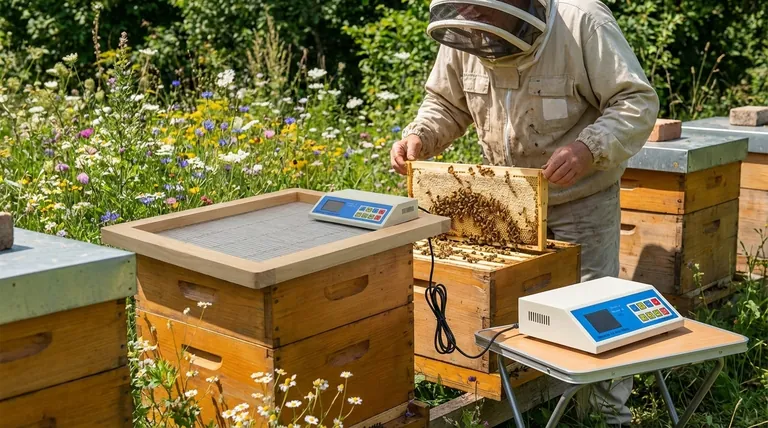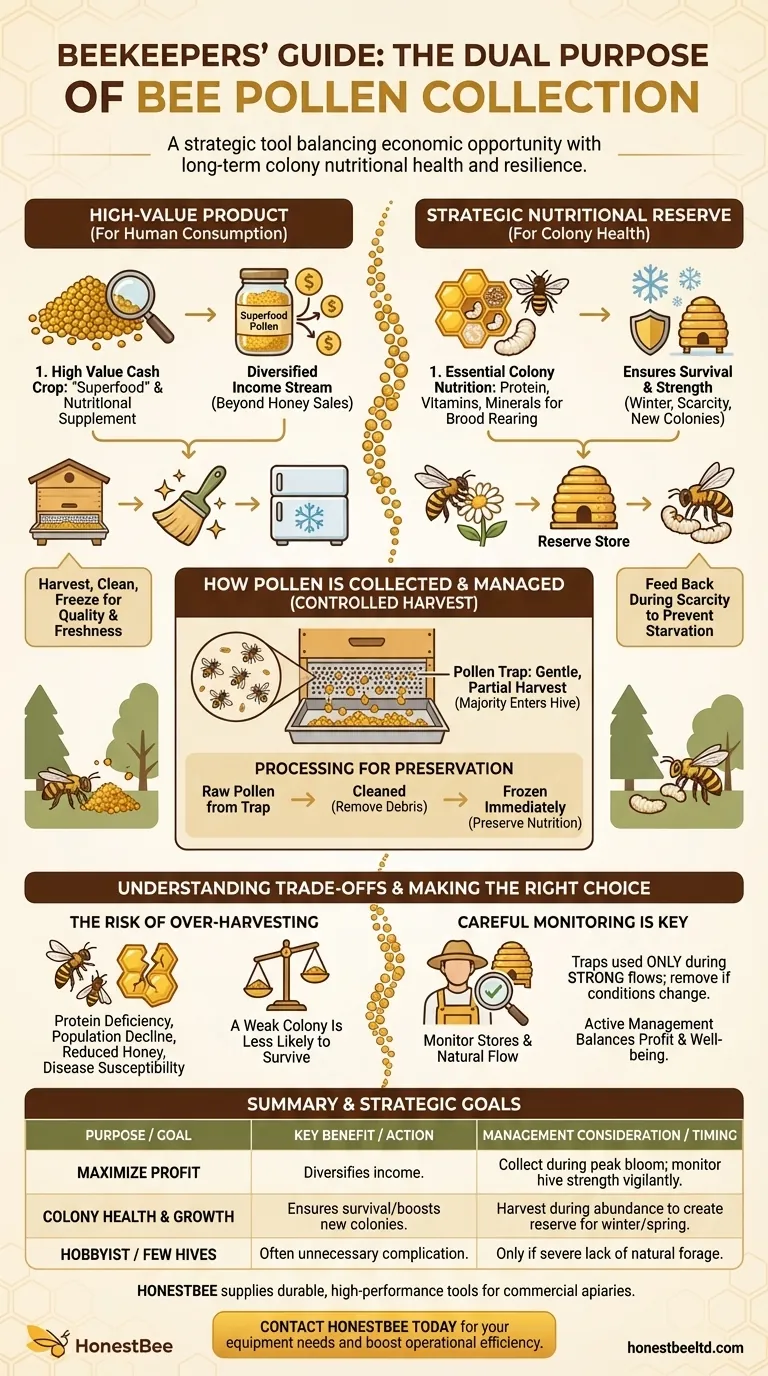For a beekeeper, collecting bee pollen serves two distinct and equally important purposes. It is harvested both as a high-value cash crop for human consumption and as a strategic food reserve to be fed back to the bees, ensuring the colony's survival and strength during periods of scarcity.
Pollen collection is not merely a harvest; it is a strategic management tool. It allows a beekeeper to balance the immediate economic opportunity of selling a high-value product against the long-term necessity of ensuring the colony's nutritional health and resilience.

The Dual Purpose of Bee Pollen
Bee pollen is the primary source of protein, vitamins, and minerals for a honey bee colony. Without it, bees cannot raise new brood (young bees), and the hive's population will collapse. Understanding this is key to grasping why beekeepers manage it so carefully.
As a High-Value Product for Human Consumption
Many beekeepers collect pollen for its economic value. It is marketed to consumers as a "superfood" or nutritional supplement, prized for its perceived health benefits and used as an ingredient in various food products.
This provides a direct, alternative revenue stream for the beekeeper, diversifying their income beyond just honey sales. The process involves harvesting, cleaning, and carefully preserving the pollen to maintain its freshness and quality for the market.
As a Strategic Nutritional Reserve for Bees
The second, equally critical purpose is to support the bees themselves. Beekeepers will collect pollen during times of abundance and store it to feed back to their colonies later.
This supplementation is vital during specific periods, such as the cold months of winter or when establishing a new, young colony. It is also used in areas where natural pollen sources are insufficient, preventing the bees from starving and ensuring the queen continues to lay eggs.
How Pollen is Collected and Managed
The method of collection is designed to be a partial harvest, ensuring the colony is not deprived of this essential resource.
The Pollen Trap: A Controlled Harvest
Beekeepers use a device called a pollen trap, which is fitted to the hive entrance. It contains a screen with small holes that are easy for a bee to pass through.
As the bees squeeze through the screen, some of the pollen pellets packed on their hind legs are gently dislodged and fall into a collection tray below. This method is designed to harvest only a fraction of the incoming pollen, allowing the majority to still enter the hive for the colony's own needs.
Processing for Preservation and Use
Once collected from the trap, the raw pollen is cleaned to remove any hive debris or impurities.
To preserve its nutritional value and prevent spoilage, the fresh pollen is typically frozen immediately. From there, it can be packaged for sale to consumers or stored for later use as a supplemental food source for the bees.
Understanding the Trade-offs
While beneficial, pollen collection is an advanced beekeeping technique that requires careful judgment and introduces potential risks if managed improperly.
The Risk of Over-Harvesting
The most significant risk is over-harvesting. If a beekeeper takes too much pollen, the colony will suffer from a protein deficiency.
This directly impacts their ability to raise brood, leading to a decline in population, reduced honey production, and increased susceptibility to diseases. A weak colony is less likely to survive the winter or other environmental stresses.
The Need for Careful Monitoring
A responsible beekeeper never collects pollen passively. They must constantly monitor the colony's internal pollen stores and the availability of natural pollen in the surrounding environment.
Traps should only be used during strong pollen flows and should be removed immediately if conditions change or if the colony shows signs of stress. This active management is critical to balancing profit with the hive's well-being.
Making the Right Choice for Your Goal
Deciding whether to collect pollen depends entirely on your objectives as a beekeeper.
- If your primary focus is maximizing profit: Collect pollen during peak floral blooms but monitor hive strength vigilantly to ensure you are not sacrificing long-term honey production for short-term pollen sales.
- If your primary focus is colony health and growth: Harvest pollen during periods of abundance specifically to create a reserve that can be fed back during winter or to boost new colonies in the spring.
- If you are a hobbyist with a few healthy hives: Pollen collection is often an unnecessary complication unless you live in an area with a severe lack of natural forage.
Ultimately, managing bee pollen is a powerful tool that separates passive beekeeping from active, strategic apiary management.
Summary Table:
| Purpose | Key Benefit | Management Consideration |
|---|---|---|
| High-Value Product | Diversifies income beyond honey sales. | Requires careful cleaning, freezing, and packaging for market. |
| Nutritional Reserve | Ensures colony survival during winter/scarcity. | Must avoid over-harvesting to prevent protein deficiency in bees. |
| Strategic Tool | Balances immediate profit with long-term hive health. | Requires active monitoring of hive strength and natural pollen flow. |
Optimize Your Apiary's Productivity and Resilience
Strategic pollen management is key to a thriving, profitable beekeeping operation. HONESTBEE supplies commercial apiaries and beekeeping equipment distributors with the durable, high-performance tools needed for success—from reliable pollen traps to essential hive equipment.
Let our wholesale-focused expertise help you strengthen your colonies and diversify your revenue streams. Contact HONESTBEE today to discuss your equipment needs and boost your operational efficiency.
Visual Guide

Related Products
- Full Set Beekeeping Electronic Bee Venom Collector Machine Device for Bee Venom Collecting
- Professional Galvanized Hive Strap with Secure Locking Buckle for Beekeeping
- Nicot Queen Rearing Kit for Beekeeping and Grafting in Nicot System
- HONESTBEE 6 Frame Three Use Electric Honey Extractor for Beekeeping
- Retractable Chinese Queen Rearing Grafting Tools Equipment
People Also Ask
- How frequently should pollen be harvested from the traps? Ensure Optimal Hive Health & Superior Quality
- What method is used to collect venom from honey bees? A Guide to Modern, Non-Lethal Extraction
- How long is each colony of bees 'milked' for venom collection? The 5-Minute Rule for Sustainable Harvesting
- How is the venom collection apparatus utilized across multiple hives? A Guide to Efficient Rotation & Bee Health
- How much venom can be collected from a single bee? A Microscopic Yield of Immense Value



















